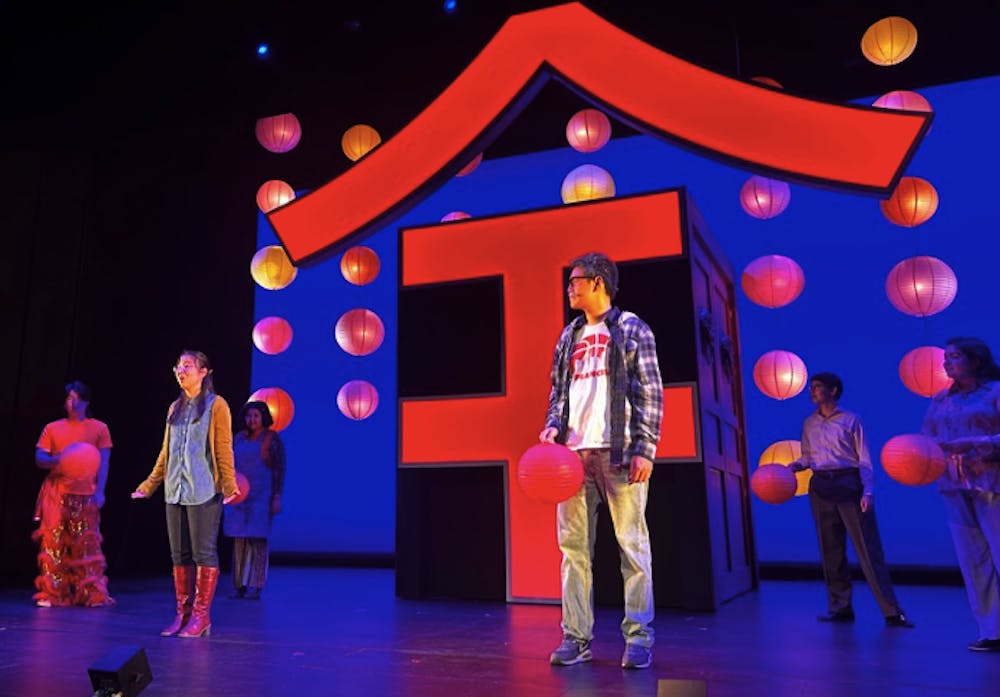A set of rose-red doors adorned with golden, circular door knockers stood at the center of the stage in Berlind Theatre at the McCarter Theatre Center. Its imposing grandeur greeted and intrigued theater-goers at the Saturday show of “King of the Yees” by playwright Lauren Yee.
As it turns out, these doors were the entrance to the Yee Fung Toy Family Association, a Chinese-American men’s club headed by the titular figure Larry Yee. This establishment is the foreground for the story of an Asian-American family trying to reconcile cultural misunderstandings and generational differences. The show transversed a typical storyline of adventure, conflict, and epiphany by consistently interweaving in humor and references to relevant issues involving the Asian-American community.
The performance opened with a comedic bit between the characters, namely the protagonist Lauren Yee, her father Larry Yee, and the narrators, where their chaotic dynamic was infused with tropes of the struggle with the Chinese-American identity, a profound internal conflict for Lauren. As the child of first and second-generation Chinese immigrants, that underlying theme of the play’s introduction resonated with me.
What began as a comedy that instilled a light-hearted mood turned out to be very effective in captivating the audience’s attention with its meaningful emotional undertones. As the play transitioned into a more personal, melancholic scene that highlighted the tension in Lauren Yee and her father’s relationship, the audience was further drawn into the plot.
Act 1 came to a dramatic close when blue spotlights encircled the characters of anonymous newscasters, who read out the monologue of Larry Yee’s disappearance. With this news, the stage lighting shied into a soft, cerulean blue hue, quickly fading into darkness to signal intermission.
Processing everything I had just seen from the first half of the show, I was amazed at how creative and exciting the stage design was. The fog seeping out of the red doors towards the conclusion of Act 1 was a nice touch to establish the mysterious circumstances in which Larry Yee’s character disappeared.
The use of the gong and drums made for powerful, dramatic sound effects, especially for scenes when the narrators and characters said the name of a secretive gangster known as “Shrimp Boy.” Every time this nickname was said out loud, a loud pound of the gong and a brief flash of the lights arose. Although this achieved the goal of establishing the fear and forbidden nature of referencing the gangster, the flashing lights felt a bit overwhelming and over-the-top, as they were constantly used throughout the play.
This one element which didn’t quite work for me was more than made up for by the lively, full-bodied voices of all the actors and actresses as they projected their lines. Their speech carried varied intonations, easily transitioning between smooth, sassy, and even gruff tones. This not only gave their characters an unpredictably intriguing aura, but also contributed to the strong sense of humor that remained a prevalent theme throughout the entire performance.
For Act 2, Lauren Yee discovers that she must go on a journey to find her missing father. She embarks on a magical expedition throughout Chinatown — where the boundary between reality and fantasy is blurred — to find the information and items she needs to rescue Larry Yee before it’s too late for him.
In this part of the play, magenta lighting was used for many scenes, especially those involving mystical characters like the Oracle, an elderly, prophetic trio who provides Lauren with much-needed information to save her father, and the long-bearded healer, who utilizes acupuncture and chiropractic to provide Lauren the ability to speak Chinese. It was interesting that the pink-purple lighting was utilized for these moments, as the gentle vibrancy of that color fittingly connoted the magical realism that was applied to various aspects of Chinese culture in the play, such as the lion dance and Sichuan opera.
Even more clever was the creative playfulness of the production. Actors sat among the audience before coming onto stage, ran down the aisle during a transition scene, and appeared on different parts of the balcony above and behind the seats. This kept the audience immersed and engaged with the play, as they turned their heads in many different directions to keep up with everything.
Comedic components were continually incorporated in seemingly grave moments or monologues, making the scenes more enjoyable while portraying messages regarding the status of the Asian-American community — for instance, their portrayal in the media, stereotypes, visibility, and more.

When Lauren finally managed to gather all the things she needed to reconnect with Larry, her reunion with her father was heart-felt, as they both acknowledged a newfound understanding of each other. Though her journey to get there involved her developing an appreciation of her Chinese heritage, her reconciliation with her father allowed Lauren to truly embrace her identity as not only an Asian-American but a Yee as well, bridging the gap of generational differences, cultural rejection, and identity denial.
To symbolize the clarity and pride that Lauren gained from her Asian-American identity, the final scene consisted of the characters coming onto the stage with paper lanterns in hand. As the lights dimmed a second time, signaling the end of the play, a series of scarlet globes glowed across the stage with streams of warm-colored paper lanterns hanging in the backdrop.
The lanterns faintly illuminated Berlind Theatre just as they had illuminated the consciousness of identity for Lauren Yee, daughter of the King of the Yees.
Russell Fan is an assistant editor for The Prospect at the 'Prince.' He can be reached at rf4125@princeton.edu, or on Instagram @russell__fan.








